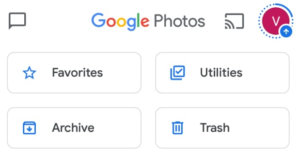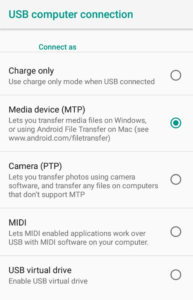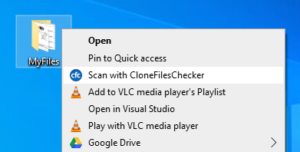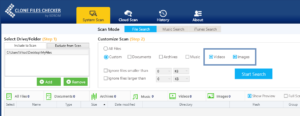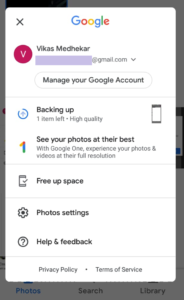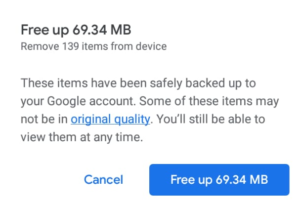Google Photos is a free photo storage and sharing service from the search engine giant. You can use Google Photos to backup and synchronize your photos from a mobile, tablet and share with other family devices.
Product Spotlight: Use PictureEcho to scan and delete similar photos from your Google Photos backup. PictureEcho is a verfied app.
Store Unlimited Photos & Videos
You can store unlimited number of photos upto 16 megapixels and videos upto 1080p screen resolution using the High Quality mode. Your photos are compressed to take less space and some original quality might be impacted. The Original Quality in contrast gives only 15 GB of free storage. Your photos are backed up with the full resolution. Upgrading will extend your storage quota.
Sync Edits Across Devices
When you make changes to a photograph stored on one device, the same version will be accessible on your other devices. Google Photos continuously monitors changes made to your files and updates them on the other end.
Face Grouping
Face grouping is a key feature that provides personalized creations, personalized search experience, and contacts suggestions. This feature is currently rolled out in specific countries only.
- Easier recognition of your faces
- Makes it easier for your contacts to share photos with you
- Suggests your contacts to share their photos containing you
- Grouping of similar faces
AI-powered Assistant
Do you love taking photos in rapid succession? Google’s AI-powered Assistant will help you turn your photos into small animated GIFs, motion photos, panoramas, collages, and a lot more.
Managing your photo library is not a big deal with Google Photos. Now, search for photos with descriptive keywords such as “kittens”, “horses” and the personalized search will narrow down your results. Not just humans, Google Photos remembers the faces of your pets as well.
Raw Files Supported
Raw files are the uncompressed images taken by your digital camera. As a result, they are usually large in size and take longer upload/ download time. Google Photos support different RAW image file formats. If you’re using a Canon, Fuji, Nikon, Olympus, Panasonic or Sony camera, you’re fully covered.
Google Photos Vs Traditional Storage Drives
Google Photos is preferred over traditional medium of storage because:
- It simplifies and automates the task of photos management
- Instant backup with single tap
- Automated backup every time you take a new photo or edit existing photos
- Your photos are just click-away. They’re available anytime, anywhere even if you are traveling abroad.
- No need to carry an external hard drive or USB stick with you
- Fully customizable. Google Photos gives users an option to turn off photo syncing if they’re running on mobile data.
- Freedom to choose folders you want to backup.
- CD/ DVD discs, external hard drives, SD memory cards, USB sticks can unexpectedly fail and stop functioning. They’re also prone to wear and tear, physical damage, water damage and other unexpected conditions. Google Photos in contrast is a Web-based app that does not suffer from any of these factors. It will continue to run even during a natural disaster (provided you have an Internet connection).
Retrieve Google Backup Photos
The restore process will make your restored photos reappear in the Google Photos library. You can access such photos or videos from your family devices.
1.Open the Google Photos app.
2. Tap the Library icon on the bottom right.
3. Select Trash.
4. Tap Trash.
5. In the subsequent page, tap Restore.
6. Select the photos you want to restore, and tap Restore again.
Delete Duplicate Photos After Retrieval
After retrieving your backed up photographs, it is important to check them for duplicates. As a photo addict, you probably have thousands of photographs scattered across your device. Your phone may reach maximum storage capacity and all those daunting warnings will start appearing. The more apps you use, the higher chances of accumulating duplicates. Several instances of the same photographs or videos may be found in different locations such as Downloads, Screenshots, WhatsApp Images, WhatsApp Videos, and so on. At some point of time, you would even no longer be able to take new screenshots, download a file or perform basic tasks.
Clone Files Checker is an algorithm-based utility software. It hashes the contents of your files to identify duplicates. It supports photos, documents, videos, music and compressed archives. Simply put, Clone Files Checker refreshes your photo library and optimizes it to reclaim lost storage.
1.Connect your Android smartphone to your PC using a USB cable.
2. Your phone will display a push notification- “USB charging this device”. Click that notification.
3. In the subsequent screen, select the Media Type (MTP) option.
4. Double-click This PC on your computer’s desktop and open-up your phone’s drive.
5. Move the contents of Pictures, DCIM and other relevant folders to a separate folder “My Files” on your computer’s Desktop.
6. Now, right-click the “My Files” folder and select “Scan with CloneFilesChecker” option.
7. In the Clone Files Checker, select the Custom option, followed by Videos and Images.
8. Hit Start Search and wait until it is completed.
9. Once the scan is completed, the results will be displayed on your screen.
10. Use the Select Duplicates button to auto-select duplicates based on a criteria of your choice. For example: Newest/ oldest files in each group, Last modified/ most modified, etc.
11. Click on Select Action and choose whether to delete your duplicates permanently or move them to a new folder.
23. After finishing up all the above steps, move back your original files into the respective folders on your phone’s drive (Pictures, DCIM, etc).
Auto-delete Backed Up Content from Device
One of the key features of Google Photos is auto-delete. Google Photos will backup your photos, videos online and delete them from your device. Not only will this free-up your storage but also improve the device performance. Your device will run faster, smoother and without glitches.
To auto-delete backed-up images, do the following:
1.Open the Google Photos app on your Android smartphone or tablet.
2. Click on the Profile picture on the top right corner of your screen.
3. Tap Free up space.
4. A pop-up warning shall appear on your screen. Review the number of files and total storage occupied.
5. Tap Free Up to confirm removal.
6. Google Photos will start backing-up your photos online and delete them from your device.
Warning: Undefined array key "author_box_bio_source" in /home1/clonefil/public_html/blog/wp-content/plugins/molongui-authorship/views/author-box/parts/html-bio.php on line 2
Vikas is a technology enthusiast who loves writing articles on computers and technology. He writes on various topics related to software, software reviews, troubleshooting and tips & tricks to make people's digital lives better.


